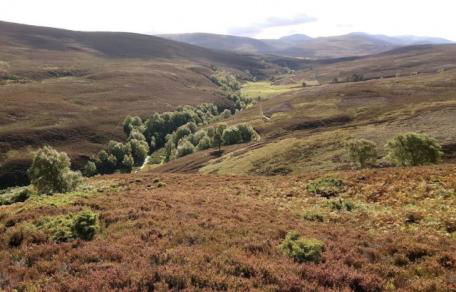CAIRNGORMS NATIONAL PARK FOREST STRATEGY 2018
Dave Windle
In our response to the consultation, we made the following key points:—
- Comparisons with Scotland as a whole (e.g. relative shares of forest cover),
while interesting, are not a good basis for planning within the Park. The
Park forest strategy should be more ambitious.
- We feel that the biodiversity of commercial plantations is often over-stated,
as are their employment prospects, especially when worker mobility and machinery
advances are taken into account.
- The role of Park forests as the environment for activities such as walking
and cycling is unclear, but traversing long "tunnels" of mature
trees is unappealing and sufficient viewpoints with medium and long-term prospects
should be provided (and managed).
- The vision needs to emphasise the role that forests can play in natural
flood management both within and beyond the Park boundaries.
- The strategy should promote a clear preference for natural regeneration
rather than by planting. This can be achieved by e.g. eliminating muirburn
in specific areas.
- Why does the vision for 2118 talk of increased deer numbers? – surely the
objective is to get the numbers down and then maintain a lower stable population
with balanced deer stalking removing the right number of animals every year?
 |
| © Cairngorm National Park Authority |
- The objectives are weak and very general. They could apply to many areas.
- The special qualities of the Park need to be explicitly recognised. For
example, almost no special mention is made of the remnants of the Old Caledonian
Pine Forest. They are a key feature of the many protected area designations
covering the area, are of international importance, and should receive special
mention.
- The strategy should recognise more explicitly the Park Authority's limited
powers in this area, than simply by its frequent use of "encourage"
or "promote".
- As is pointed out, moorland managed for grouse shooting covers approximately
40% of the Park, a major proportion. It is a disgrace that the best that current
grouse moor management practice can do is to achieve some regeneration along
roadsides. Elsewhere, "In some locations isolated native trees have been
deliberately and systematically removed to expand moorland habitat."
Targets should be set for all moors to stop muirburn over, say, 5 - 10% of
their area, the areas least suitable for rearing grouse, in order to allow
trees to regenerate.
- We endorse the guidance that "Natural regeneration of native tree
species should be encouraged on the forest-moorland margins to provide an
increase in habitat diversity and woodland connectivity to benefit a wide
variety of species."
- The Park should work with developers and the Forestry Commission to ensure
that all tracks and borrow pits needed for proposed new forests are included
in initial forestry plans, rather than being introduced on an incremental
basis at later stages.
- The guidance on forest felling is weak. Such work too often results in
many years of almost complete inaccessibility on foot of previously felled
areas now covered by brash and/or crossed by deep ruts caused by heavy machinery,
with minimal attention paid to restoring churned-up tracks.
- We are very doubtful that "Collaboration between neighbouring deer
managers to achieve deer densities compatible with woodland regeneration is
encouraged" will be sufficient and believe that stronger regulation of
deer management will be necessary. The document needs to align itself with
the modern need to really manage deer numbers and be ready to take on board
the recommendations of the Deer Working Group, which should be mentioned.
- We strongly support the guidance that "Early and thorough consideration
should be given to the positive and negative landscape impact of new woodland,
especially in wild land and other sensitive areas"; and that "New
woodland should be designed to enhance perceptions of naturalness and wildness
in the landscape in the long term and to keep short term negative visual impacts
to a minimum."
- We are doubtful that "There is huge (sic) potential in the National
Park to invest in a forest resource that will provide local employment and
increase opportunities for future enterprise from marketing and refining local
forest products".
NEMT Front Page
| Previous Page | Volume Index
Page | Next Page | Journal Index Page
Please let the webmaster know if there
are problems with viewing these pages or with the links they contain.

